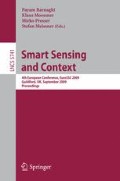Abstract
A robust activity and context-recognition system must be capable of operating over a long period of time, exploiting new sources of information as they become available and evolving in an autonomous manner, coping with user variability and changes in the number and type of available sensors. In particular, wearable and ambient nodes should be trained lifelong, as new context instances naturally arise, and the labeling of the instances should be carried out ideally with no user intervention. In this paper we show by means of an experiment and simulations that we can indeed achieve lifelong learning and automatic labeling by using Context Cells, an architecture capable of sensing, learning, classifying data and exchanging information.
Access this chapter
Tax calculation will be finalised at checkout
Purchases are for personal use only
Preview
Unable to display preview. Download preview PDF.
References
Stiefmeier, T., Roggen, D., Ogris, G., Lukowicz, P., Tröster, G.: Wearable activity tracking in car manufacturing. IEEE Pervasive Computing 7(2), 42–50 (2008)
Van Laerhoven, K., Gellersen, H.W.: Spine versus porcupine: a study in distributed wearable activity recognition. In: Proceedings of Eighth International Symposium on Wearable Computers (ISWC), pp. 142–149. IEEE Computer Society Press, Los Alamitos (2004)
Logan, B., Healey, J., Philipose, M., Tapia, E.M., Intille, S.S.: A long-term evaluation of sensing modalities for activity recognition. In: Krumm, J., Abowd, G.D., Seneviratne, A., Strang, T. (eds.) UbiComp 2007. LNCS, vol. 4717, pp. 483–500. Springer, Heidelberg (2007)
Tentori, M., Favela, J.: Activity-aware computing for healthcare. IEEE Pervasive Computing 7(2), 51–57 (2008)
Harms, H., Amft, O., Roggen, D., Tröster, G.: Smash: A distributed sensing and processing garment for the classification of upper body postures. In: Third interational conference on body area networks (2008)
Bao, L., Intille, S.S.: Activity recognition from user-annotated acceleration data. In: Pervasive Computing: Proc. of the 2nd Int’l Conference, pp. 1–17 (2004)
Weiser, M.: The computer for the 21st century. Pervasive Computing 1(1), 19–25 (2002)
SPINE: http://spine.tilab.com/ (Last seen May 15, 2009)
Lombriser, C., Roggen, D., Stäger, M., Tröster, G.: Titan: A tiny task network for dynamically reconfigurable heterogeneous sensor networks. In: 15. Fachtagung Kommunikation in Verteilten Systemen (KiVS), pp. 127–138 (2007)
Zhao, H., Yuen, P.C., Kwok, J.T.: A novel incremental principal component analysis and its application for face recognition. IEEE Transactions on Systems, Man, and Cybernetics Part B 36, 873–886 (2006)
Polikar, R., Upda, L., Upda, S., Honavar, V.: Learn++: an incremental learning algorithm for supervised neural networks. IEEE Transactions on Systems, Man, and Cybernetics, Part C: Applications and Reviews 31(4), 497–508 (2001)
Freund, Y., Schapire, R.E.: A decision-theoretic generalization of on-line learning and an application to boosting. Journal of Computer and System Sciences 55(1), 119–139 (1997)
Angluin, D., Laird, P.D.: Learning from noisy examples. Machine Learning 2(4), 343–370 (1988)
Author information
Authors and Affiliations
Editor information
Editors and Affiliations
Rights and permissions
Copyright information
© 2009 Springer-Verlag Berlin Heidelberg
About this paper
Cite this paper
Calatroni, A., Villalonga, C., Roggen, D., Tröster, G. (2009). Context Cells: Towards Lifelong Learning in Activity Recognition Systems. In: Barnaghi, P., Moessner, K., Presser, M., Meissner, S. (eds) Smart Sensing and Context. EuroSSC 2009. Lecture Notes in Computer Science, vol 5741. Springer, Berlin, Heidelberg. https://doi.org/10.1007/978-3-642-04471-7_10
Download citation
DOI: https://doi.org/10.1007/978-3-642-04471-7_10
Publisher Name: Springer, Berlin, Heidelberg
Print ISBN: 978-3-642-04470-0
Online ISBN: 978-3-642-04471-7
eBook Packages: Computer ScienceComputer Science (R0)

